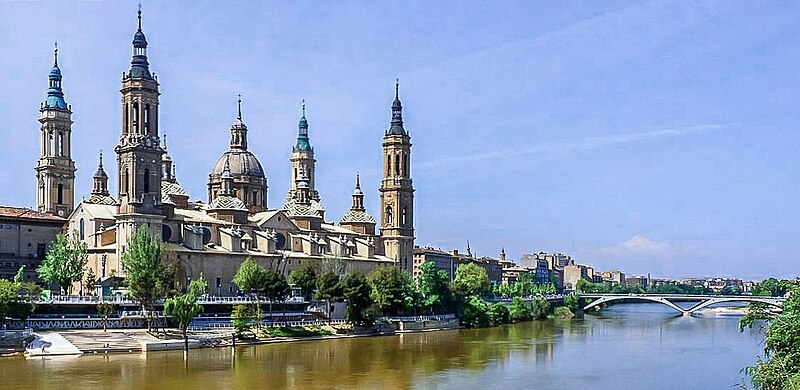Zaragoza, Spain: Bridging Cultures, Ancient Legacies, and Aragonese Splendor

Nestled along the Ebro River in the heart of Aragon, Zaragoza emerges as a cultural crossroads where ancient history, medieval architecture, and modern vitality converge. As the fifth-largest city in Spain, Zaragoza is a captivating destination that invites exploration of its diverse heritage, religious significance, and the vibrant pulse of contemporary life. Join us on an expansive journey through the winding streets, historic landmarks, and cultural treasures that define the alluring essence of Zaragoza.
Historical Roots and Architectural Treasures:
Zaragoza’s roots reach deep into antiquity, with evidence of Iberian and Roman settlements shaping its early history. The city’s name itself, derived from the Roman name Caesaraugusta, reflects its imperial past. The Roman Theatre, discovered in the 1970s, stands as a tangible testament to Zaragoza’s ancient origins, offering a glimpse into the theatrical entertainments enjoyed by the citizens of Caesaraugusta.
The iconic Aljafería Palace, a UNESCO World Heritage site, encapsulates centuries of history within its walls. Originally built as a fortress during the Islamic period, the Aljafería later served as a royal residence for Christian monarchs. Its Mudejar and Gothic architecture, coupled with lush gardens, epitomize the city’s ability to preserve and showcase its diverse cultural influences.
The Basilica of Our Lady of the Pillar:
Zaragoza’s spiritual heart beats within the Basilica of Our Lady of the Pillar, a monumental sanctuary that holds immense religious significance. According to legend, the Virgin Mary appeared to Saint James the Apostle at this very spot, making it one of the most revered pilgrimage sites in Spain. The basilica’s Baroque façade and the twelve apostles adorning the exterior lead visitors into a sacred interior adorned with frescoes, paintings, and intricate altars.
The Feast of Our Lady of the Pillar, celebrated on October 12th, draws pilgrims and revelers alike, transforming Zaragoza into a vibrant hub of religious processions, concerts, and cultural events.
La Seo Cathedral and the Mudéjar Ensemble:
Adjacent to the Basilica stands La Seo Cathedral, a magnificent example of Gothic, Mudéjar, and Renaissance architecture. The cathedral’s intricately carved choir stalls, chapels, and the Renaissance altarpiece contribute to its status as a UNESCO World Heritage site.
Zaragoza’s Mudéjar Ensemble, including the towers of the Cathedral, La Seo, and the Church of San Pablo, represents a unique blend of Islamic and Christian architectural styles. The Mudéjar influence, characterized by intricate geometric patterns and vibrant tilework, reflects the city’s historical coexistence of cultures.
Zaragoza’s Bridges and the Ebro River:
The Ebro River, Spain’s longest river, gracefully winds its way through Zaragoza, contributing to the city’s picturesque landscapes. The stone bridges that traverse the river showcase both historical engineering and contemporary design. The Puente de Piedra, or Stone Bridge, with its iconic statues of saints, is a symbol of Zaragoza’s connection to the past.
The Puente de la Almozara, a modern bridge designed by Zaha Hadid, stands as a testament to the city’s commitment to architectural innovation. The riverbanks, adorned with parks and promenades, provide serene settings for leisurely walks, boat rides, and panoramic views of the city.
Zaragoza’s Plazas and Vibrant Urban Life:
Zaragoza’s plazas, or squares, are lively hubs that reflect the city’s contemporary vitality. The Plaza del Pilar, flanked by the Basilica and La Seo, is a central gathering place for locals and tourists alike. The Plaza de España, with its monumental fountain and shaded benches, invites relaxation in the heart of the city.
The lively Plaza de Santa Marta, surrounded by bars and restaurants, exemplifies Zaragoza’s social spirit. Locals often gather in these squares to enjoy tapas, sip on a glass of regional wine, and partake in the cherished tradition of socializing in the open air.
Culinary Delights and Local Flavors:
Zaragoza’s gastronomic scene is a celebration of Aragonese flavors, blending traditional dishes with contemporary culinary trends. The city’s central market, Mercado Central, is a vibrant tapestry of colors and aromas. Local vendors offer fresh produce, cured meats, cheeses, and regional specialties, allowing visitors to embark on a culinary journey through Aragon.
Traditional dishes like migas (breadcrumbs with garlic, paprika, and chorizo), ternasco (roast lamb), and bacalao ajoarriero (salted cod with garlic and peppers) showcase the rich gastronomic heritage of the region. Zaragoza’s taverns, bodegas, and tapas bars offer an authentic taste of Aragonese cuisine, creating a delightful fusion of flavors.
Zaragoza’s Museums and Cultural Institutions:
Zaragoza is home to a diverse array of museums that cater to art enthusiasts, history buffs, and science lovers. The Pablo Serrano Museum, housed in a 16th-century Renaissance palace, showcases contemporary art and sculpture. The CaixaForum Zaragoza, a cultural and exhibition center, hosts a variety of artistic and educational events.
The Museum of Natural Sciences, Museo Goya, and the IAACC Pablo Serrano contribute to Zaragoza’s cultural landscape, offering insights into the city’s natural history, artistic legacy, and contemporary arts scene.
Festivals and Celebrations:
Zaragoza comes alive with festivals that infuse the city with color, music, and joy. The Fiestas del Pilar, held in honor of the Virgin of the Pillar, is one of the most significant celebrations. The streets are adorned with floral offerings, processions, and cultural events that attract visitors from across Spain.
Zaragoza’s Festival of La Cincomarzada, celebrated on March 5th, is a lively event marked by picnics, concerts, and family-friendly activities in the city’s parks.
Conclusion:
Zaragoza, with its ancient legacies, religious significance, and Aragonese splendor, stands as a city that bridges the past and present with grace. Whether wandering through its historic streets, marveling at its architectural wonders, or savoring the flavors of Aragon, Zaragoza invites visitors to experience the richness of its cultural tapestry. In the shadow of the Basilica’s towers, along the banks of the Ebro River, and within the vibrant plazas that pulse with life, Zaragoza unfolds as a city that encapsulates the spirit of Aragon and the enduring charm of Spanish heritage.




